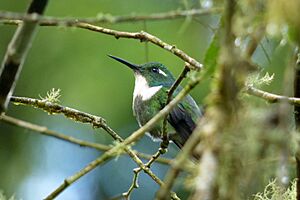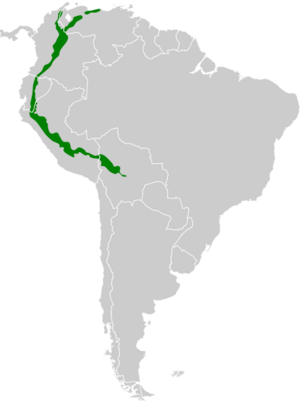Geoffroy's daggerbill facts for kids
Quick facts for kids Geoffroy's wedgebill |
|
|---|---|
 |
|
| Conservation status | |
| Scientific classification | |
| Genus: |
Schistes
|
| Species: |
geoffroyi
|
 |
|
| Synonyms | |
|
Augastes geoffroyi (Bourcier, 1843) |
|
The Geoffroy's daggerbill (Schistes geoffroyi) is a tiny, colorful hummingbird. It gets its name from its very sharp, pointed beak, which looks a bit like a small dagger! You can find this amazing bird in South American countries like Bolivia, Colombia, Ecuador, Peru, and Venezuela.
Contents
About This Hummingbird
How Scientists Name Birds
For a long time, Geoffroy's daggerbill was thought to be the same species as another bird, the white-throated daggerbill. They were both called "wedge-billed hummingbirds." But in 2018, bird experts decided they were different species. Now, most groups call this bird the "daggerbill" because of its unique beak.
Different Kinds of Geoffroy's Daggerbill
There are two main types, or subspecies, of Geoffroy's daggerbill. They are called S. g. geoffroyi and S. g. chapmani. They look very similar, but have small differences.
What Does It Look Like?
Geoffroy's daggerbill is a small bird, about 8.6 to 9.3 centimeters (about 3.5 inches) long. It weighs only 3.5 to 4.1 grams, which is less than a nickel!
Colors and Markings
Male daggerbills have shiny, bronzy-green feathers on their backs. Their throats are a sparkling golden-green with bright violet patches on the sides. They also have white patches on their chest and a long white stripe behind their eyes. Their bellies are green. Female daggerbills look similar, but their throats are white with green speckles instead of bright colors. The S. g. chapmani subspecies is like the main one, but it doesn't have the white patches on its throat.
Where It Lives
Its Home in the Mountains
The main type of Geoffroy's daggerbill (S. g. geoffroyi) lives in the Andes Mountains. You can find it from Venezuela, south through Colombia and Ecuador, all the way to Peru. The other type (S. g. chapmani) lives further south, from Peru into central Bolivia.
Preferred Habitat
These hummingbirds love to live inside and at the edges of thick cloudforests. These are forests high in the mountains that are often covered in clouds. They usually live at elevations between 900 and 2,300 meters (about 3,000 to 7,500 feet) above sea level. Sometimes, they can be found even higher!
How It Behaves
Moving Around
Geoffroy's daggerbill usually stays in one area. However, after they have babies, they might move to different elevations in the mountains.
What It Eats
This hummingbird finds its food in thick plants, from close to the ground up to medium heights. It sips nectar from the tube-shaped flowers of shrubs, vines, and small trees. It also catches tiny insects while flying, or sometimes picks them off plants.
Reproduction and Life Cycle
In Venezuela, Geoffroy's daggerbill breeds from August to November. The female builds a cup-shaped nest using soft seed fibers and spider silk. She decorates the outside of the nest with lichens. She usually lays two eggs. The female sits on the eggs for 15 to 16 days until they hatch. The young birds are ready to fly about 20 to 22 days after hatching.
Its Song
The song of Geoffroy's daggerbill sounds a bit like an insect. It's a series of simple "tsit" or "sink" notes, sung from a low branch.
Conservation Status
The IUCN (International Union for Conservation of Nature) says that Geoffroy's daggerbill is a species of "Least Concern." This means that even though we don't know exactly how many there are, their population seems to be stable. They are not considered to be in danger, and they live in several protected areas.
Images for kids



